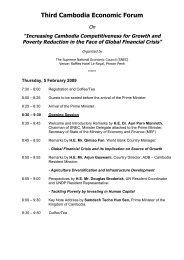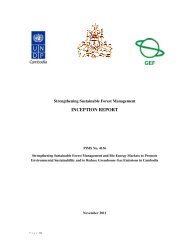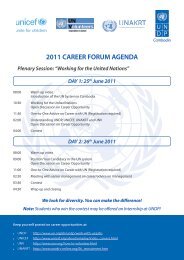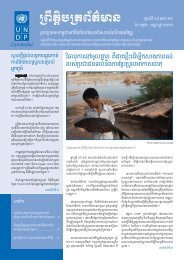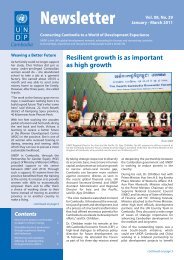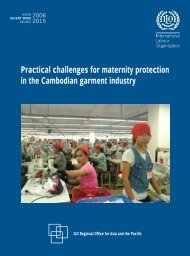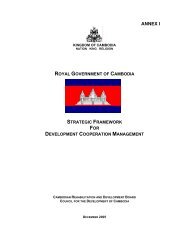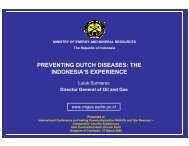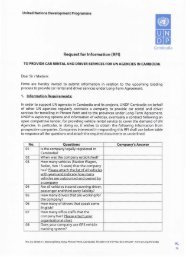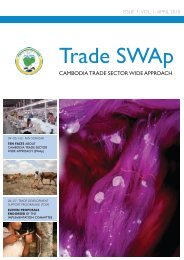UN Analysis Final.pdf - United Nations in Cambodia
UN Analysis Final.pdf - United Nations in Cambodia
UN Analysis Final.pdf - United Nations in Cambodia
Create successful ePaper yourself
Turn your PDF publications into a flip-book with our unique Google optimized e-Paper software.
of modern methods (CDHS 2005). Those aged 20-24 had even better knowledge, at 99.2 per cent and 99<br />
per cent, respectively. In practice, however, the use of contraception among married women rema<strong>in</strong>s low,<br />
with 20.8 per cent of the 15-19 age group report<strong>in</strong>g the current use of any method, and 13.7 per cent<br />
report<strong>in</strong>g the use of a modern method. The proportions are higher among the 20-24 age group, with<br />
34.6 per cent report<strong>in</strong>g us<strong>in</strong>g any method and 23.3 per cent report<strong>in</strong>g us<strong>in</strong>g a modern method. The most<br />
popular method of contraception by young married women is the pill, followed by withdrawal and<br />
<strong>in</strong>jectables (Table 6-1). Information does not appear to exist on unmarried people’s knowledge and use<br />
of contraceptives.<br />
Table 6-1. Contraceptive method use by currently married women aged 15-24, 2005 (%)<br />
Contraceptive method 15-19 20-24<br />
All married women 100.0 100.0<br />
Contraception 20.8 34.6<br />
Daily pill 7.0 10.7<br />
Monthly pill 0.6 1.6<br />
IUD 1.7 1.0<br />
Injectables 1.6 6.3<br />
Male condom 2.8 3.0<br />
Rhythm 1.2 3.3<br />
Withdrawal 5.9 7.9<br />
Other 0.1 0.6<br />
Not currently us<strong>in</strong>g 79.2 65.4<br />
Source: CDHS 2005<br />
KNOWLEDGE OF SEXUAL AND REPRODUCTIVE HEALTH<br />
Accord<strong>in</strong>g to FGD participants, both young males and females have a good understand<strong>in</strong>g of sexual and<br />
reproductive health and related <strong>in</strong>fections. Youth <strong>in</strong>terviewees stated that they learned from sexual education<br />
and awareness campaigns provided by NGOs <strong>in</strong> their villages, and <strong>in</strong> school. They mentioned tra<strong>in</strong><strong>in</strong>g<br />
provided by the Reproductive Health Association of <strong>Cambodia</strong> (RHAC) on sexual and reproductive health<br />
and HIV and AIDS. Some also cited other sources of <strong>in</strong>formation such as television, village and community<br />
library <strong>in</strong>formation boards, the latter be<strong>in</strong>g supported by the NGO, Open Forum of <strong>Cambodia</strong>. FGD<br />
participants also cited peer educators <strong>in</strong> their villages as another <strong>in</strong>formation source.<br />
Besides learn<strong>in</strong>g from school, I received tra<strong>in</strong><strong>in</strong>g on sexual and reproductive health from a local NGO, called<br />
RHAC, through its staff, who often come to my village. The tra<strong>in</strong><strong>in</strong>g conducted <strong>in</strong> the village gathers all the<br />
youth and sometimes both parents to participate <strong>in</strong> the tra<strong>in</strong><strong>in</strong>g also. I have also learnt through the<br />
community library <strong>in</strong> the village and from the TV <strong>in</strong> my house... – FGD, 15-19 year old female, Sangker<br />
village, Svay Rieng<br />
Although there has been improvement <strong>in</strong> terms of <strong>in</strong>creased awareness of sexual and reproductive health<br />
among young people, the depth of penetration across the country is not clear. Key <strong>in</strong>formants suggest that<br />
where there are no NGO or governmental programmes, awareness is much more limited. They also observed<br />
Situation <strong>Analysis</strong> of Youth <strong>in</strong> <strong>Cambodia</strong><br />
69




